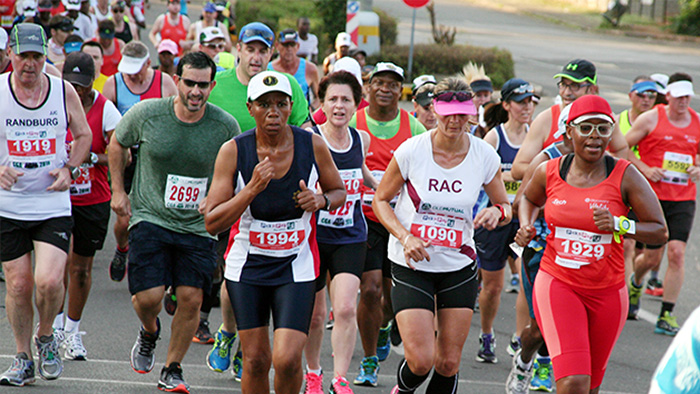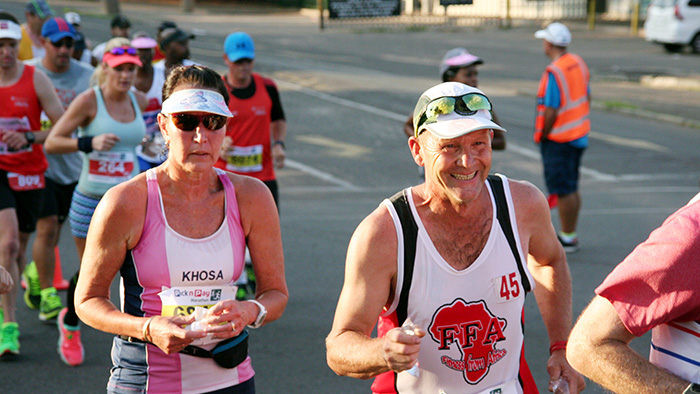One of my favourite runners from yesteryear is the Czech Emil Zatopek. Known as a notoriously hard worker, at the 1952 Helsinki Olympics, Zatopek became the first and almost certainly the only man in Olympic history ever to win the three long-distance events – 5,000m, 10,000m and marathon. What is even more remarkable is that it was the first time he had raced the full marathon distance and did so only three days after winning the 10,000m final! He won all three events within seven days, and set Olympic records in them all. By the end of that year he held every world record from the 10,000m to the marathon, and in 1954 he added the 5,000m world record as well. All in all he set 18 world records during his career.
Zatopek’s training comprised of interval work based on speed and stamina. His rationale for this type of training was simple: “When I was young, I was too slow. I thought, why should I practise running slow? I already know how to run slow – I must learn to run fast by practising to run fast”.
In our distance-crazed country here in South Africa, we tend to do the opposite and become frustrated at our forever slowing marathon times. I have heard many a runner remark after a slow marathon or ultra event: “I need to increase my mileage”. The runner would dutifully add another 15-30km per week, to experience similar or even worse results. The irony is that we are doing a fantastic job of teaching our bodies how to be slow!
I have experienced this myself as a result of getting caught up in the mileage hype leading up to the 90km Comrades marathon. In the lead up to my first Comrades marathon in 1998, I came off a speed and track background, and ran a solid time of just under seven hours. Excited about it all, I decided that I needed more mileage. So I did away with the speed and increased the mileage, or at least tried to. What followed was one injury after another and diminishing results on top of it.
Just as dynamic Springbok coach Jake White remarked that for a successful rugby team you need pure speed on the wings, so too do we need speed to be the best we can be as marathon and ultra marathon runners.

Every year toward the third weekend in November, the Rand Athletic Club in the north of Johannesburg hosts the running of the Tough One 32km road race. As the name indicates it is a very challenging event to say the least! Towards the end of the 2007 RAC Tough One I stood in awe as I saw Olympian and 1,500m specialist Juan van Deventer stride away from some of the top half and marathon runners in the country to win the race by a comfortable margin. In preparation for the Olympics in Beijing at the time, van Deventer had done all the speed preparation one could hope for, and then as part of his off-season training he added a bit of mileage and came away the victor in arguably the country’s most popular 20 mile event!
It’s far easier to add mileage to a program rich in quality, than to add quality to a program high in mileage.
Former world record holder Sebastian Coe’s dad Peter, was quoted as saying that “Why should we drain the life out of a young runner, when you can develop it with quality?”
More recently we also saw how young American runner and Olympic silver 10,000m medallist, Galen Rupp, raced to victory at the US Olympic marathon trials, winning his maiden marathon in 2h11min. Running tactically!
Well known sports researcher, Prof Tim Noakes, says that speed work requires more finesse and understanding than does long, slow distance running as it is more likely to cause injury and physical breakdown. Having said that, one needs to ease into the world of interval training, yet anticipate new levels of achievement once the adaptation occurs. What makes interval and speed training so beneficial to us as marathon and ultra distance runners? Successful American coach Dr Jack Daniels proposes that there are six physiological processes, each of which needs to be adapted optimally, if the athlete is to achieve his or her optimum competitive performance:
- Improving the body’s ability to transport blood and oxygen.
- Increasing the ability of the running muscles to use the available oxygen efficiently.
- Raising the lactate threshold to a faster running speed.
- Increasing aerobic capacity and elevating the VO2Max.
- Improving running speed.
- Lowering the energy demand of running, i.e. improving running economy.
Starting to recognise a theme here? One or two runners have asked me why they need to do 300 and 400m repetitions if they are ultra marathon runners? The six reasons above explain it very nicely. By enhancing your body’s energy systems and improving running economy, the benefit spills over from track or quality training to 10km racing, to the marathon and eventually to the ultra marathon!

If we have a look at the some of the Comrades greats, we will see that they were all able to do a 10km race in 30min or faster! By doing so they could tick over at 3m30 per kilometre during an ultra race and hardly extend their effort over 70% of maximum! In other words, during the first half of the race they may well be surrounded by ten or twenty reasonably talented runners although these guys could be sitting at 80% or full capacity. When they eventually run out of glycogen it’s not a pretty sight. Most of these runners will be reduced to a walk by the time there are still 30km to be run!
So what are the components of speed training? Exercise scientist Pete Pfitzinger describes the five components of training:
- Short, fast speed work to improve leg turnover and running form.
- Longer repetitions of two to six minutes at 3-5km race pace to improve VO2Max.
- Tempo runs of 20-40min at 15km race pace to improve the lactate threshold.
- Long runs to build endurance.
- Easy recovery runs to allow a maximum effort on the hard training days.
It sounds easy enough although quality training is quite daunting. Many a weekend warrior will rather go out for an easy 10km jog, than to line up for 4 x 1km repeats at 85% intensity with 3min recovery. Many ultra or marathon runners would rather jog an easy 32 km than race an all out 10 km race. Many ultra distance runners would rather do a hilly 25km route than 8 x 300m hill repeats. Many ultra distance runners would rather increase the weekly miles one more time than getting down to some good old sweat and tears on the track.
Many ultra distance runners will achieve amazing things at the standard marathon and the Comrades marathon. Which one will you be this year?

